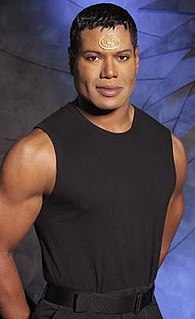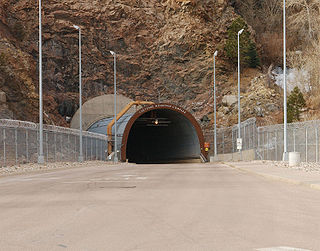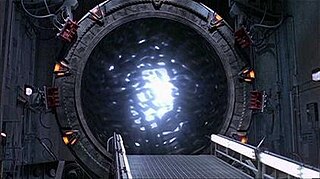
CMSgtTeal'c of Chulak is a fictional character in the military science fiction television series Stargate SG-1. Portrayed by Christopher Judge, Teal'c is a Jaffa warrior from the planet Chulak. As a Jaffa, Teal'c is a genetically modified human with an abdominal pouch that serves as an incubator for a larval Goa'uld. The larval symbiote grants enhanced strength, health, healing, and longevity; Teal'c is around 100 years old during the show's run and ages an additional 50 years in the final SG-1 episode. Teal'c's most notable feature is a golden tattoo found on his forehead, a sign that he once served the System Lord Apophis as First Prime, the most senior Jaffa rank.

The Goa'uld are a symbiotic race of ancient aliens from the American-Canadian military science fiction television franchise Stargate. The Goa'uld are parasites from the planet P3X-888, integrated within a host. The resulting creatures are a powerful race bent on galactic conquest and domination, largely without pity, compassion, or remorse. In the first eight seasons of Stargate SG-1, they are the greatest extraterrestrial threat to Earth known to the Stargate Command (SGC). The Goa'uld are the main enemies of SG-1 for most of the show, until they are replaced in this capacity by the Ori in seasons 9 and 10. They also appear in the Stargate Atlantis episode "Critical Mass", and in the DVD movie Stargate: Continuum. They are pejoratively called "snakes" or "snakeheads" by Jack O'Neill.

The Stargate Program is a fictional special access program that plays a key role in the Stargate franchise: it surrounds the operations of the Stargate on Earth. The core of the Stargate Program is Stargate Command (SGC), based at the Cheyenne Mountain Air Force Station near Colorado Springs, Colorado. During the run of Stargate SG-1, the NID is most critical of the Stargate Program, while the program is extended through the establishment of the Office of Homeworld Security/Homeworld Command and the International Oversight Advisory (IOA). The Atlantis Project as seen in Stargate Atlantis is part of the Stargate Program but works independently during season 1 of the show.

A Stargate is an Einstein–Rosen bridge portal device within the Stargate fictional universe that allows practical, rapid travel between two distant locations. The devices first appear in the 1994 Roland Emmerich film Stargate, and thereafter in the television series Stargate SG-1, Stargate Atlantis, and Stargate Universe. In these productions, the Stargate functions as a plot generator, allowing the main characters to visit alien planets without the need for spaceships or any other type of technology. The device allows for near-instantaneous travel across both interstellar and extragalactic distances.

Dr. Elizabeth Weir is a fictional character in the Canadian-American Sci-Fi Channel television series Stargate Atlantis, a military science fiction show about a military team exploring another galaxy via a network of alien transportation devices. Elizabeth Weir is introduced as a recurring character in the Stargate SG-1 season seven two-parter, Lost City. She does not hold any military rank since she is a civilian. Weir is the leader of the Atlantis expedition in Stargate Atlantis until the last episode of season three, titled "First Strike".

In the fictional universe of Stargate, a number of technologically advanced races and societies have produced a variety of highly advanced weapons, tools, and spacecraft. By liaising with these races and learning from them, Earth too has begun to create its own futuristic technology. All such technology is SCI-classified top secret, and is used mainly by the SGC, its SG teams, or in Atlantis.
In the fictional universe of the Stargate franchise, the people of Earth have encountered numerous extraterrestrial races on their travels through the Stargate. In addition to a diversity of alien life, there is also an abundance of other humans, scattered across the cosmos by advanced aliens in the distant past. Some of the most significant species in Stargate SG-1 are the Goa'uld, the Asgard, and the Replicators. Stargate Atlantis, set in the Pegasus galaxy, introduced the Wraith and the Asurans. One of the most influential species in Stargate, the Ancients, have moved on to a higher plane of existence. For practical reasons of television productions, almost all of the alien and human cultures in the Stargate's fictional universe speak native English. Because of the time constraints of an hour-long episode, it would become a major hindrance to the story each week if the team had to spend a sizeable part of each episode learning to communicate with a new species.
"Reckoning" is a two-part episode from Season 8 of the science fiction television series Stargate SG-1. It resolves the long-running story arcs of the Goa'uld, the Replicators, and the Jaffa Rebellion, and are regarded as two of the most popular episodes of the series. This episode was nominated for an Emmy Award in the category "Outstanding Special Visual Effects for a Series" and a Leo Award in the category "Best Visual Effects".)
"New Order" is the two-part Season 8 premiere of the science-fiction series Stargate SG-1. The episode earned a 2.4 Nielsen rating, a new record high for the show during its run on cable, which has since been tied, but never beaten. It also became the most-watched regular series episode ever for the Sci Fi Channel and the highest rated episode in the history of Stargate SG-1, drawing 3.22 million viewers. Part 2 was nominated for a Gemini Award in the category "Best Visual Effects".)
"Revelations" is the Season 5 finale episode of the science fiction television series Stargate SG-1. This episode was nominated for an Emmy in the category "Outstanding Special Visual Effects for a Series", and won a Gemini Award in the category "Best Visual Effects".
This is a list of the Goa'uld characters that appear in Stargate, Stargate SG-1, and Stargate Atlantis. In the Stargate fictional universe, the Goa'uld are a parasitic alien race that use other beings as hosts. Ra had stated in the original Stargate film that he had used humans exclusively as hosts for millennia, because Goa'uld technology can repair human bodies so easily that by inhabiting human forms they can be in effect ageless, though they can still be injured or killed. Most Goa'uld pose as gods in order to control slave armies, and are considered evil, egocentric megalomaniacs by those who do not worship them. The Goa'uld are extremely intelligent and have an aptitude for understanding, working with, and using technology that is superior to that of humans. They each have full access to their species' genetic memory from the moment of birth. As a result, no Goa'uld has to learn how to operate any technological device; they 'know' how to do so innately.
This is a list of Goa'uld technologies in the Stargate franchise. The Goa'uld are the main adversaries for most of the run of Stargate SG-1. They scavenged or conquered most of their advanced technologies from other races. However, there are innovators amongst the Goa'uld; Anubis and Ba'al in particular have been depicted with a great deal of technological ingenuity. Rather than being designed as practical, many Goa'uld devices, such as the staff weapon, are designed to have higher visual impact, meant to intimidate and reinforce their position as gods to their followers. Some pieces of Goa'uld technology, such as the hand device and the healing device, respond only to mental commands and require naqahdah in the bloodstream of the user to operate.
In the Stargate fictional universe, the Ancients, also known as the Alterans and Lanteans, are the most advanced race known to have existed, having evolved millions of years prior to the present day and reaching their level of technology long before Human life evolved on Earth.














